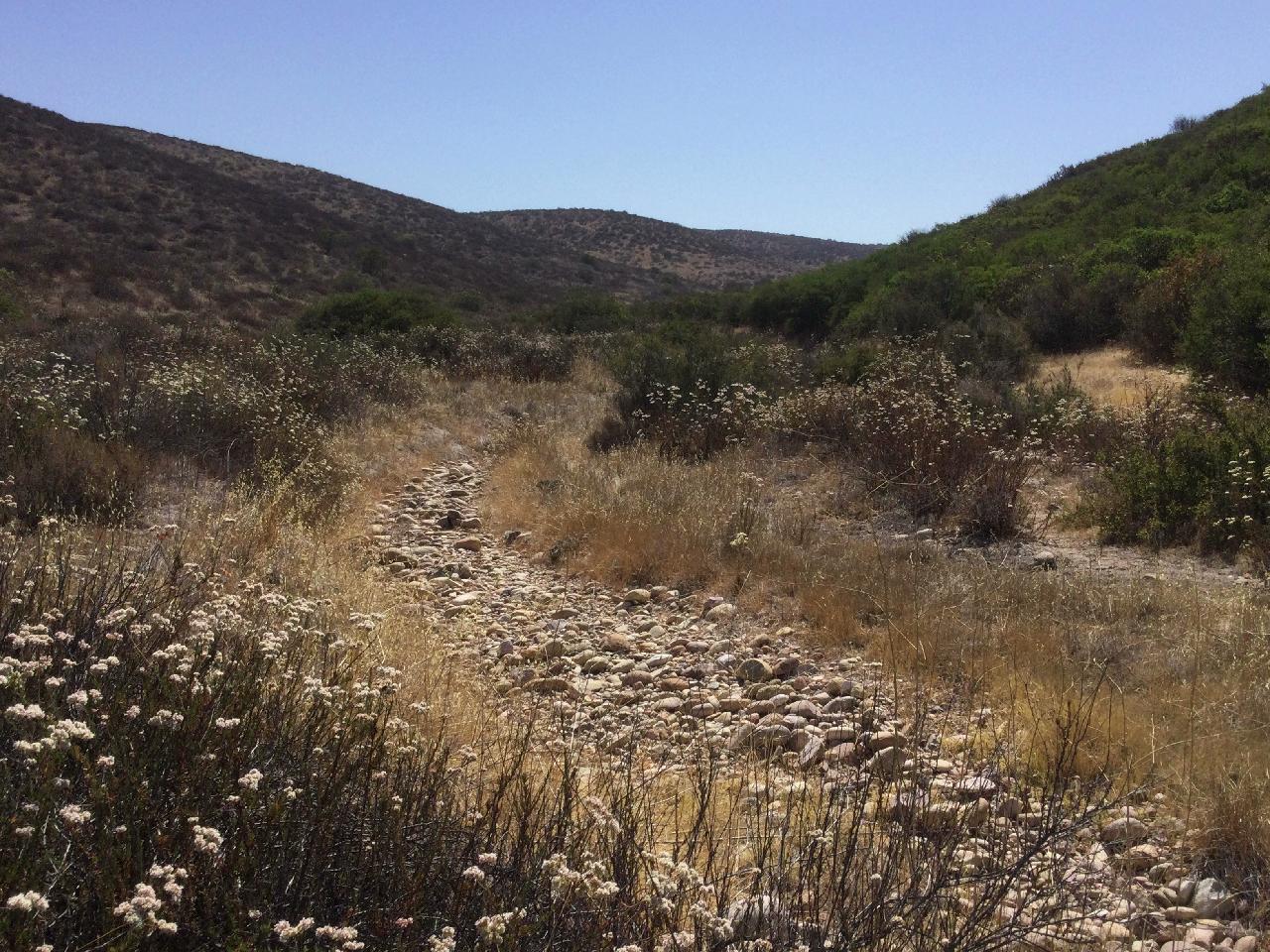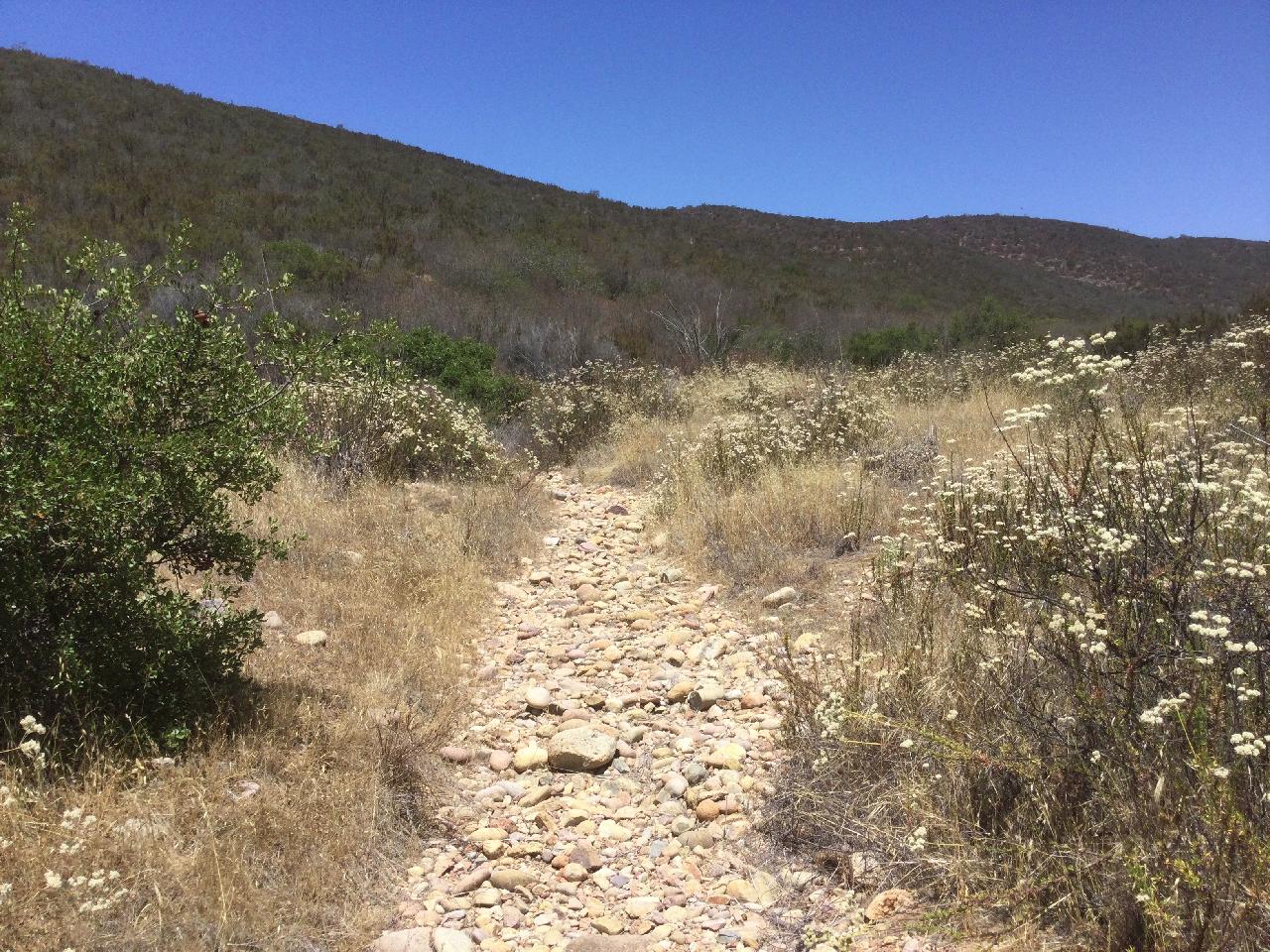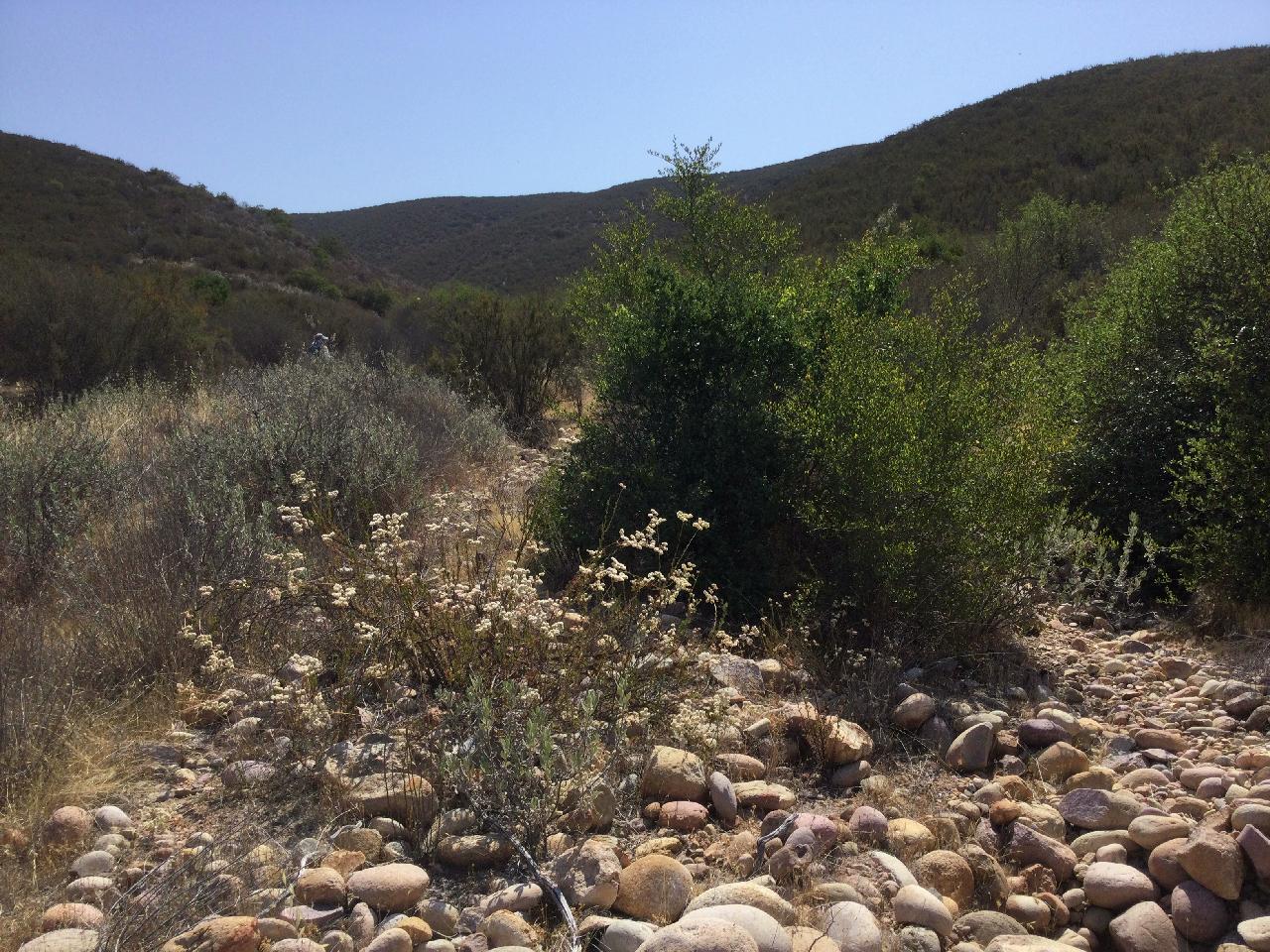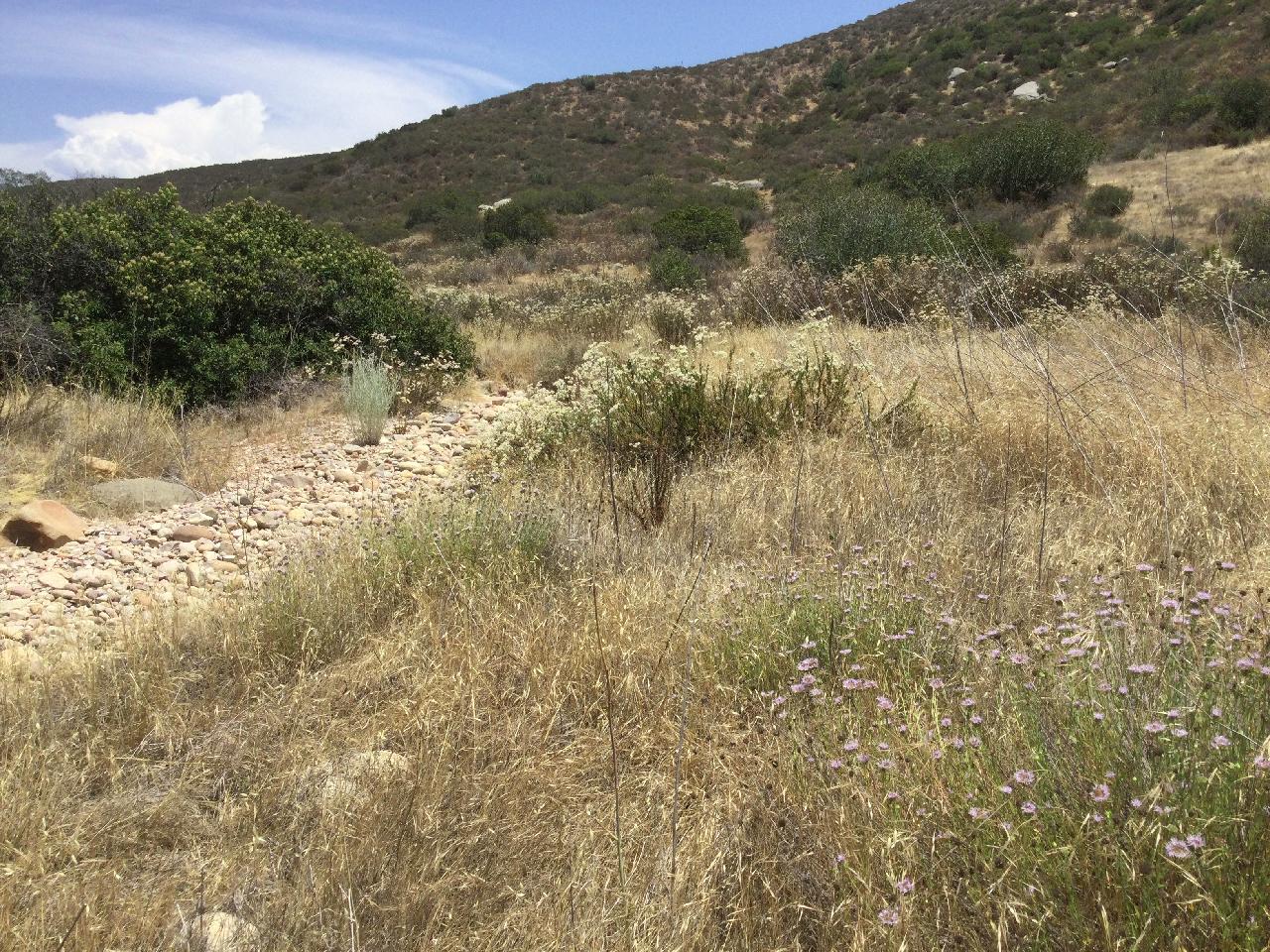Assessment of Willowy Monardella (Monardella viminea) Status, Habitat, and Threats on Conserved Lands in San Diego County
The updated Framework Rare Plant Management Plan for
Conserved Lands in Western San Diego County (FRPMP) released in 2021 included a species-specific management plan for willowy monardella that recommended a framework for managing known populations and suggested the
following information needs: 1) Identify sites where willowy monardella has been extirpated but
would be suitable for reintroduction, 2) Identify locations that contain suitable habitat for willowy
monardella to be introduced into, and 3) Develop hydrology models based on analysis of
locations where monardella exists to identify which areas of suitable habitat have hydrology
most conducive to the establishment and survival of willowy monardella.
The FRPMP recommendations include the field collection of data regarding the physical and
biotic characteristics, hydrology, and levels of disturbance in existing populations of willowy
monardella and ground-level assessment of other locations that may support the same
characteristics as the known locations. This project addresses these recommendations.
The goal of these assessments is to identify potential receptor sites for establishment of new
willowy monardella populations or locations of historical populations suitable for reintroduction of
willowy monardella. The assessment also evaluated management needs within these suitable
receptor locations as well as existing, occupied drainages. Receptor sites and management actions were identified through the collection of data about the physical and biotic
characteristics, hydrology, and levels of disturbance.
Project Focus
Willowy monardella
Emily Perkins
San Diego Association of Governments
AECOM
San Diego Management and Monitoring Program
Kris Preston
Sarah McCutcheon
Kris Preston
Willowy monardella Monardella viminea
Goal: Maintain or enhance existing willowy monardella occurrences and establish new occurrences, as needed, to ensure multiple conserved occurrences with self sustaining populations to increase resilience to environmental and demographic stochasticity, maintain genetic diversity, and ensure persistence over the long term (>100 years) in coastal sage scrub vegetation communities.
MGT-PRP-MGTPL MONVIM-7
Management units: 4, 6
In 2020, begin preparing a section for willowy monardella in the MSP Rare Plant Management Plan that prioritizes management actions to maintain the large occurrence and enhance at least 4 small occurrences on Conserved Lands (see occurrence table) based upon an assessment of data on occurrence status, habitat and threats. Prepare prioritized management recommendations to re-establish historic occurrences or new occurrences in suitable habitat, if determined to be necessary for gene flow and to maintain self sustaining populations for the long term persistence of the species in the MSPA. Minimum criteria for enhancement are to reduce invasive annual nonnative plants and thatch to less than 20% absolute cover within the occurrence.
| Action | Statement | Action status | Projects |
|---|---|---|---|
| PRP-1 | Consult the San Diego County Rare Plant Working Group made up of plant ecologists, geneticists, rare plant experts, land managers, restoration practitioners, seed banking and bulking practitioners, wildlife agencies, MCAS Miramar, and other stakeholders to provide input and recommendations for the willowy monardella section in the MSP Rare Plant Management Plan. | waiting for precedent action | |
| PRP-2 | Develop a conceptual model that identifies management actions to effectively reduce threats to willowy monardella occurrences. | waiting for precedent action | Assessment of Willowy Monardella (Monardella viminea) Status, Habitat, and Threats on Conserved Lands in San Diego County |
| PRP-3 | Prioritize occurrences for management based upon an assessment of occurrence status, the potential for management to significantly reduce identified threats, and the availability of adjacent suitable habitat for occurrence expansion. | waiting for precedent action | |
| PRP-4 | Develop an implementation plan for willowy monardella that prioritizes management actions for the next 5 years and details tasks, lead entities, responsibilities, and timelines, budgets. | waiting for precedent action | Assessment of Willowy Monardella (Monardella viminea) Status, Habitat, and Threats on Conserved Lands in San Diego County |
| PRP-5 | Submit project metadata and MSP Rare Plant Management Plan to the MSP Web Portal. | waiting for precedent action | Assessment of Willowy Monardella (Monardella viminea) Status, Habitat, and Threats on Conserved Lands in San Diego County |
| Criteria | Deadline year |
|---|---|
| By 2020, Completed Willowy Monardella Section in MSP Rare Plant Management Plan | 2021 |
| Threat Name | Threat Code |
|---|---|
| Altered fire regime | ALTFIR |
| Altered hydrology | ALTHYD |
| Climate change | CLICHN |
| Human uses of the Preserves | HUMUSE |
| Invasive plants | INVPLA |
| Urban development | URBDEV |
Willowy monardella Monardella viminea
Goal: Maintain or enhance existing willowy monardella occurrences and establish new occurrences, as needed, to ensure multiple conserved occurrences with self sustaining populations to increase resilience to environmental and demographic stochasticity, maintain genetic diversity, and ensure persistence over the long term (>100 years) in coastal sage scrub vegetation communities.
MGT-IMP-MGTPL MONVIM-8
Management units: 4, 6
In 2021, begin implementing highest priority management actions identified for willowy monardella in the MSP Rare Plant Management Plan.
| Action | Statement | Action status | Projects |
|---|---|---|---|
| IMP-1 | Submit metadata, management datasets, and report to the MSP Web Portal. | waiting for precedent action | Assessment of Willowy Monardella (Monardella viminea) Status, Habitat, and Threats on Conserved Lands in San Diego County |
| Criteria | Deadline year |
|---|---|
| By 2024, =2 High Priority Management Action Implemented for Willowy Monardella from the MSP Rare Plant Management Plan | 2021 |
| Threat Name | Threat Code |
|---|---|
| Altered fire regime | ALTFIR |
| Altered hydrology | ALTHYD |
| Climate change | CLICHN |
| Human uses of the Preserves | HUMUSE |
| Invasive plants | INVPLA |
| Urban development | URBDEV |
Willowy monardella Monardella viminea
Goal: Maintain or enhance existing willowy monardella occurrences and establish new occurrences, as needed, to ensure multiple conserved occurrences with self sustaining populations to increase resilience to environmental and demographic stochasticity, maintain genetic diversity, and ensure persistence over the long term (>100 years) in coastal sage scrub vegetation communities.
MON-SURV-SPEC MONVIM-4
Management units: 4, 6
In 2019, survey historic willowy monardella locations to determine occurrence status; survey and delineate potentially suitable habitat for new occurrences; survey existing occurrences to identify the potential for enhancement and expansion; and at all sites collect data on occurrence status, habitat and threats and determine management needs. Conduct a hydrological evaluation at each site to determine the current hydrology and risk to existing or potential occurrences from erosion and flooding. Prioritize all evaluated sites based on feasibility of maintaining a sustainable population over the long term and recommend management needed to reduce threats to existing and potential new occurrences.
| Action | Statement | Action status | Projects |
|---|---|---|---|
| SURV-1 | At each extant occurrence, map the extent of the occurrence, collect data on abundance, map adjacent suitable habitat for potential occurrence expansion, collect covariate data on threats including estimates of cover of invasive non-native plants and trampling. | on hold | |
| SURV-2 | Submit project metadata, habitat mapping, and a report with site prioritizations and recommendations for management based upon occurrence status, habitat and threats assessments and hydrological evaluations to the MSP Web Portal. | on hold | Assessment of Willowy Monardella (Monardella viminea) Status, Habitat, and Threats on Conserved Lands in San Diego County |
| Criteria | Deadline year |
|---|---|
| Surveys and Report Completed by 2019 | 2021 |
| Threat Name | Threat Code |
|---|---|
| Altered fire regime | ALTFIR |
| Altered hydrology | ALTHYD |
| Human uses of the Preserves | HUMUSE |
| Invasive plants | INVPLA |
| Urban development | URBDEV |
| File name | Lead Author | Year | Type |
|---|---|---|---|
| Assessment of Willowy Monardella Status, Habitat, and Threats on Conserved Lands in San Diego County | Maunsell, Ian; Brand Ramirez, Diana | 2022 | powerpoint presentation |
| Assessment of Willowy Monardella (Monardella viminea) Status, Habitat, and Threats on Conserved Lands in San Diego County | AECOM | 2022 | report |
| Recording - September 2022 SDMMP Management and Monitoring Coordination Meeting | Brand Ramirez, Diana; Maunsell, Ian; Perkins, Emily; Baldridge, Ann; Bacay, Ashleyann; Guia, Carolina | 2022 | recording |
Project Files
| File name |
|---|
| MOVI_Original_Public.gdb.zip |



